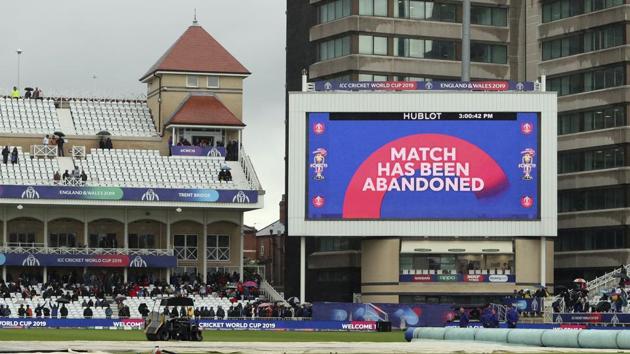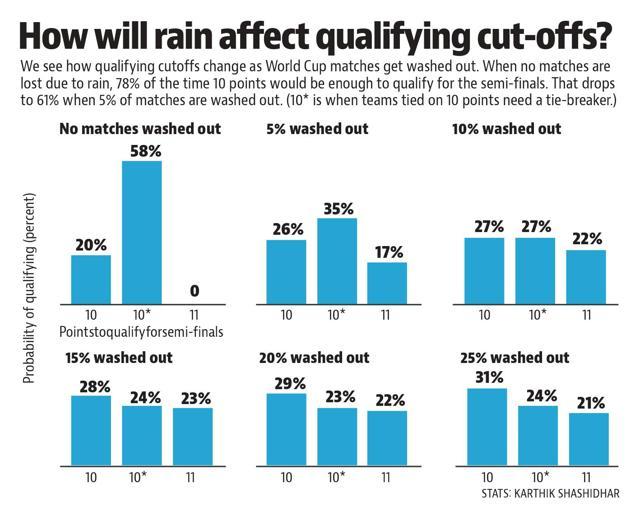ICC World Cup 2019: How washouts could affect the semi-final lineup
Keeping rain threats, curtailed overs and revised targets in mind, captains could be forced to field first, even though teams batting first have won eight (57.1%) of the 14 completed matches so far.
You sing the rain song (read kale megha, kale megha). You dance the rain dance (visualise Aamir Khan). The skies get cloudy, but there is no rain. You are forced to play a cricket match over two days and the skies open up immediately after the match. The timing is perfect. The rains promise a good crop and because you won the match, you don’t have to pay the taxes. You thank the rain gods because the match wasn’t a wash out (remember the condition was Aamir Khan’s team had to win to get a tax exemption). You had asked for everything, you got it all. That’s not possible, is it?

Well, ICC CEO Dave Richardson asked for everything (except the rain) when at The Oval on May 27, he promised the world ‘the greatest celebration of cricket ever’ at the 2019 World Cup. Whatever else he may have got, he got rain anyway. Buckets of it. So much so that there is actually a flood alert in some parts of south and southeast England at the moment. And now, as things stand, it’s not Jofra Archer, not Jasprit Bumrah, not Buttler or Bairstow or Warner or Kohli, but dark clouds that loom over every match as the X-Factor.
To chase or not to chase
Keeping rain threats, curtailed overs and revised targets in mind, captains could be forced to field first, even though teams batting first have won eight (57.1%) of the 14 completed matches so far. Pakistan chose to field against Australia on Wednesday because there was a forecast of rain and fielding first helps a team keep pace with the Duckworth-Lewis-Stern (DLS) sheet.
The rain stayed away. Pakistan went on to lose, mainly because they fielded poorly, but also because they handed over the advantage of batting first at Taunton, in the smallest ground used in this World Cup, to Australia. When the wicket is fresh the ball comes nicely onto the bat and scoring is easier; using those conditions, Australia put over 300 runs on the board.
All captains prefer batting second in rain-threatened matches, because the Duckworth-Lewis-Stern (DLS) method is easier to follow for the chasing team.
Even if there is a fair bit of scepticism around the DLS method (because the algorithm is kept a secret), at least before the start of a run chase both teams know what they need to do. The DLS sheet handed to the teams gives a par score for every ball, taking into consideration the first innings total and wickets in hand during the chase. But even then mistakes happen. South Africa skipper Shaun Pollock messed it up in the 2003 World Cup against Sri Lanka when he thought the DL par score was the target. South Africa celebrated when they got to that score, only to realise that the match had actually ended in a tie. Exit, South Africa.
The great equaliser
Again, when Richardson said 2019 was going to be ‘one of the most competitive tournaments ever’, he may not have imagined the rain gods would take it upon themselves to make his words come true.
With 18 of the 48 matches played—including three where players did not take the field and one where they could bat and bowl for just 7.3 overs—the points table is any organiser’s delight. Eight of the 10 teams are within four points of each other. There is a pacesetter in New Zealand perched atop on seven points from four. Defending champions Australia are a point adrift, with favourites India a point further back having played a match less.

And then there is a surprise package in Sri Lanka quietly creeping up a rain-soaked ladder. Quietly, because people haven’t got much of a chance to cheer for them. They lost miserably to New Zealand in the opener. They had to scrape the bottom of their resources and experience barrel to overcome ‘also rans’ Afghanistan. And then by the grace of rain managed to steal a point each against Pakistan and Bangladesh after washouts. On both occasions their opponents felt the pinch of a crucial point lost—because Pakistan, having beaten England, and Bangladesh having beaten South Africa, possibly lost the advantage they gained from beating fancies teams by losing a point against a weaker team. Both are now faced with the task of causing another major upset to squeeze into the last four.
But the worse isn’t over. With predictions of a record rainfall in June this year, more matches could see teams sharing the spoils. If that happens, the table could close down further. With prediction of rain throughout next week, England could see their relatively easy matches against Afghanistan on Tuesday and then against Sri Lanka the following Friday, get washed out. This would mean that instead of a potential four points from those matches, they get only two. Every match from then on becomes a do or die battle for the tournament favourites.
Here’s a bit of a number crunching. Without a single game washed out in this World Cup, there was an 80% chance that a team with 10 points in their nine league matches would have finished among the top four. Of that, there was a 60% chance that the last qualifier would have gone through with 10 points following a tie-breaker (NRR or head to head etc), and a 20% chance of a team with 10 points making it to the last-four stage straightaway.
But if we assume 5% of matches are washed out, the probability of 10 points being enough for a semi-final stage comes down to 60%. There’s a small chance of getting through with fewer, but now a cutoff at 11 points becomes a realistic probability (see graphic).
With Thursday’s India-New Zealand match washed out, 22.2% of matches played so far have failed to produce a result. The more the percentage of washed out games increases, the narrower the gap becomes in the points table. In other words, the possibility of qualifying with nine points progressively catches up with the possibility of qualifying with 10 points. Everything gets trickier. A lower cutoff means the chances of more teams clustering for tie-breakers increases. Don’t be surprised if at the end of the league, we have three or even four teams fighting a tie-breaker for the fourth semi-final spot.
And then what?
The focus shifts from being a battle between two teams on the field to one where you need charts and calculators. In tie-breakers, number of wins gets the highest weightage, followed by NRR, head-to-head results, and finally, pre-tournament seeding. The semis and the final have reserve days and a Super Over option, a first in 50-over cricket. In case even a Super Over is not possible over two days in the semis, then the team which finished higher in the league stage goes through to the final. If a Super Over is not possible in the final, the World Cup will be shared.
For a tournament that comes every four years and is the biggest showcase event the ICC has thus far, deciding winners off the field or on past performance becomes a damp squib. As the match between Sri Lanka and Bangladesh last week got washed out without a ball bowled, a fan tweeted with a picture of a flooded Bristol ground: ‘Sri Lanka won the toss and chose to swim’.






